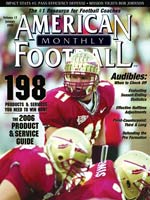AMERICAN FOOTBALL MONTHLY THE #1 RESOURCE FOR FOOTBALL COACHES
Article CategoriesAFM Magazine
|
University of Richmonds Defending the Pro Formationby: Michael ElkoLinebackers Coach, University of Richmond © More from this issue I would like to share with you our defensive philosophy on defending two-back formations with an eight-man front. When we first began developing our two-back package, we wanted to adhere to a few base principles. This article will be devoted to the decisions we make in each of these areas. Defending the pro-formation is one of the major responsibilities for defensive coaches at Richmond. Hopefully some of these ideas, while certainly not revolutionary, will spark some meaningful discussion among its American Football Monthly readers. 1. Stop the Run. Like most people, when the other team is in a two back set, our philosophy must be geared toward stopping the running game. 2. Have the Ability to Change Passing Windows. If we are successful at stopping the run, we want to make sure we have some ....The full article can only be seen by subscribers. Subscribe today!
|
|
|||||||
| HOME |
MAGAZINE |
SUBSCRIBE | ONLINE COLUMNISTS | COACHING VIDEOS |
Copyright 2025, AmericanFootballMonthly.com
All Rights Reserved





